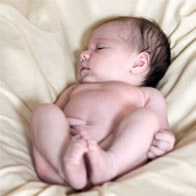Hydroceles
A hydrocele is fluid around the testicle that causes the scrotum to look swollen. Hydroceles are painless and are typically found in newborn boys, especially premature babies. You may notice a hydrocele when one of your child’s testicles looks larger than the other.
We Typically Diagnose Two Types of Hydroceles – Communicating and Non-communicating
- A non-communicating hydrocele is usually found in newborn boys. In the eighth month of pregnancy, the testicles move down into the scrotum, bringing a fluid filled sac with it, which surrounds the testicles. In normal development, the sac closes before birth and the fluid is absorbed naturally. A non-communicating hydrocele occurs when this sac closes but the fluid remains. We typically watch this kind of hydrocele over the course of your baby’s first year as in the majority of cases, the fluid is absorbed over time with no intervention necessary.
- Communicating hydroceles are synonymous with a neonatal hernia.
A hydrocele is not painful or harmful to your son, but you or your child’s doctor may notice that his scrotum is swollen. The fluid surrounding the testicle makes it difficult for your baby’s doctor to feel the testicle inside the scrotum. Oftentimes, the doctor will take a small flashlight and shine the light on your baby’s scrotum.
How is a Hydrocele Treated?
f your baby has a non communicating hydrocele, we typically take a wait and see approach as the majority of these hydroceles go away on their own by age one. If the hydrocele is still present at age one or gets larger with time, then our specialists will discuss surgery with you.
If we determine that your son has a communicating hydrocele through examination, surgery for this hernia is often recommended.
Surgery – What to Expect
To help prepare parents of young children for surgery, our pediatric urology team will walk you through the steps we will take before, during and after your child’s procedure. Prior to surgery, our staff will greet you in our ambulatory surgery center where your child will be prepped for his procedure. Dr. Adam Kern and a pediatric anesthesiologist will meet with you before the surgery to explain the procedure and make sure we have answered all of your questions.
The surgery itself is common and entails a small incision in the groin area where Dr. Kern will drain the fluid from the sac. Several small, dissolvable stitches will help reinforce the muscle wall and close the small incision. After the surgery, your son will be moved to the recovery area where our pediatric nurses will monitor him as he comes out of the anesthesia. You will be able to join your child in recovery. Most children will go home the same day.
What to Expect After Surgery
- In the recovery room, our nurses will monitor your child’s vitals as he slowly comes out of the anesthesia. Your child’s nurse will go over written instructions for caring for the surgical site once you get home. This will include how to keep the area clean. The stitches will dissolve on their own.
- You will be given specific instructions for bathing during the post-operative period.
- For older children, a three-week restriction from contact sports and gym activities is often given.
- You will then see Dr. Kern for a scheduled appointment, commonly one month post operatively to ensure the incision has healed appropriately and that the hydrocele has resolved.
Open communication is important to us. If you have any questions before or after your son’s surgery, please contact our office. We are always happy to allay any concerns or answer any questions you have about your child’s health.

